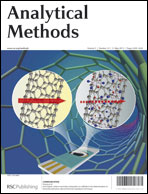A novel, precise, specific, accurate and rapid reversed-phase high performance liquid chromatographic method, with diode array detection, was developed, optimized and validated to determine the drug purity of cocaine street samples seized in Italy and to characterize the adulterants. The method was performed using a C18 column, under isocratic conditions, with potassium phosphate buffer–acetonitrile as the mobile phase, at 232 nm. Linearity was studied from 0.01 to 0.50 mg mL−1, with a determination coefficient (r2) higher than 0.9999. The limit of detection (LOD) and limit of quantification (LOQ) were 0.004 mg mL−1 and 0.01 mg mL−1, respectively. Precision was evaluated as repeatability and intermediate precision with relative standard deviations not exceeding 5%. Validation of the HPLC method was carried out following ICH guidelines. Also, the estimation of the uncertainty measurements was included. The proposed HPLC-DAD method was thus shown to be convenient and highly suitable for the routine analysis of seized samples of drugs of abuse.

You have access to this article
 Please wait while we load your content...
Something went wrong. Try again?
Please wait while we load your content...
Something went wrong. Try again?


 Please wait while we load your content...
Please wait while we load your content...